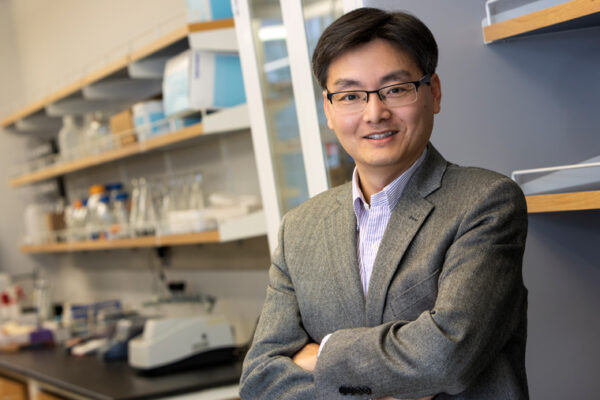Whether wastewater is full of “waste” is a matter of perspective.
“Why is it waste?” asked Zhen (Jason) He, professor in the Department of Energy, Environmental & Chemical Engineering in the McKelvey School of Engineering at Washington University in St. Louis.
“It’s organic materials,” He said, and those can provide energy in a number of ways. Then there’s the other valuable resource in wastewater.
Water.
He’s lab has developed one system that recovers both, filtering wastewater while creating electricity. Results from bench-scale trials were published May 6 and featured as a front cover article in the journal Environmental Science: Water Research & Technology.
The waste materials in wastewater are full of organic materials which, to bacteria, are food.
“Bacteria love them and can convert them into things we can use,” He said. “Biogas is the primary source of energy we can recover from wastewater; the other is bioelectricity.”
In addition to the paper’s first author, Fubin Liu, a PhD candidate at Washington University, Zhen (Jason) He had two collaborators from the Institute of Graduate Studies and Research at Alexandria University in Egypt: Mohammed Salah El-Din Hassounab and Hanan Moustafa.
“Because of this collaboration, I am hosting a Fulbright scholar and will be hosting another visiting scholar, both from Egypt,” He said.
The Egyptian researchers are interested in using similar technological platforms for water desalination. “That’s what the Fulbright scholar will be working on. … But that’s a different story.”
There already exist ways to capitalize on bacteria to produce energy from wastewater, but such methods often do so at the expense of the water, which could be filtered and otherwise be used — if not for drinking — for “grey water” purposes such as irrigation and toilet flushing.
He’s lab took the two processes — filtration and energy production — and combined them, integrating the filtration system into the anode electrode of a microbial electrochemical system.
The system is set up like a typical microbial fuel cell, a bacterial battery that uses electrochemically active bacteria as a catalyst where a traditional fuel cell would use platinum. In this type of system, the bacteria are attached to the electrode. When wastewater is pumped into the anode, the bacteria “eat” the organic materials and release electrons, creating electricity.
To filter that same water, however, requires a different system.
He’s lab combined the systems, developing a permeable anode that acts as a filter.
The anode is a dynamic membrane, made of conductive, carbon cloth. Together, the bacteria and membrane filter out 80% to 90% of organic materials — that leaves water clean enough to be released into nature or further treated for non-potable water uses.
He used a mixed culture of bacteria, but they had to share one feature — the bacteria had to be able to survive in a zero-oxygen environment.
“If there was oxygen, bacteria would just dump electrons to the oxygen not the electrode,” He said. “If you cannot respire with the electrode, you’ll perish.”
To find the correct bacteria, He mostly defers to nature.
“It’s not 100 percent natural, but we select those that can survive in this condition,” He said. “It’s more like ‘engineered selection,’” the bacteria that did survive and respire with the electrode were selected for the system.
The amount of electricity created is not enough to, say, power a city, but it is in theory enough to help to offset the substantial amount of energy used in a typical U.S. water treatment plant.
“In the U.S., about 3% to 5% of electricity is used for water and wastewater activity,” He said. Considering the usage by a local municipal plant, He believes his system can reduce energy consumption significantly.
“Wastewater is a resource in the wrong location.”
“Typically, the process consumes about 0.5 KWH of electricity per cubic meter,” He said. Based on bench scale experiments, “We can reduce it by half, or more of that.”
But the primary goal of He’s system isn’t electricity production, it’s wastewater treatment and nutrient recovery.
“Bacteria can convert those organic materials into things we can use,” He said. “We can also recover nutrients like nitrogen or phosphorus for fertilizer. We can use it to feed plants. It’s only when we don’t use it, then it becomes waste.
“Wastewater is a resource in the wrong location.”
The McKelvey School of Engineering at Washington University in St. Louis promotes independent inquiry and education with an emphasis on scientific excellence, innovation and collaboration without boundaries. McKelvey Engineering has top-ranked research and graduate programs across departments, particularly in biomedical engineering, environmental engineering and computing, and has one of the most selective undergraduate programs in the country. With 140 full-time faculty, 1,387 undergraduate students, 1,448 graduate students and 21,000 living alumni, we are working to solve some of society’s greatest challenges; to prepare students to become leaders and innovate throughout their careers; and to be a catalyst of economic development for the St. Louis region and beyond.
This work was financially supported by the faculty startup fund of Washington University in St. Louis and the U.S. – Egypt Science and Technology Joint Fund
